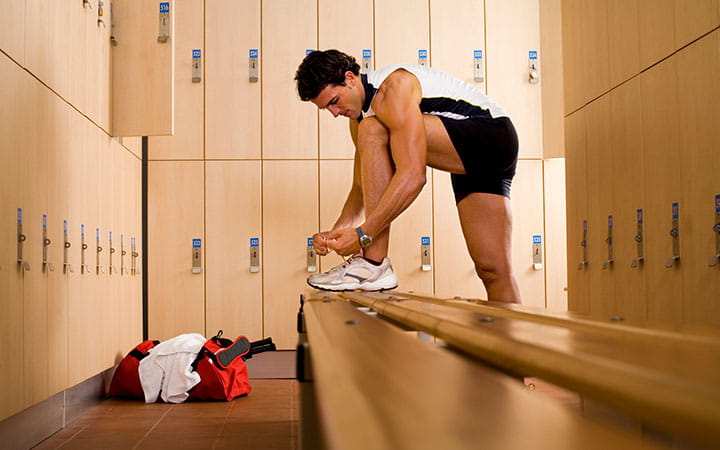Ways to Safeguard Your Health in the Locker Room
September 29, 2016

As the weather gets cooler and the days get shorter, many of us will move our workouts indoors. That means you'll spend more time in the locker room -- places that can be breeding grounds for bacteria, viruses, fungi and other maladies.
Most viruses and other contagions love humidity, which is a combination of moisture and heat.
“That pretty much describes every locker room I’ve ever been in," says physical therapist Paul M. Smith, PT, MS, AT, CGFI.
Throw on top of that the opportunity for bacteria or viruses to get into the body through an athlete's mucus membranes, like the nose or eyes, or cuts on the skin.
"So if you’re playing pick-up basketball and you get a court burn or abrasion, your skin is compromised and you have a greater opportunity to develop an ailment when you go into a high-humidity situation,” Mr. Smith says.
That doesn’t mean you need to encase yourself in a plastic bubble when you enter the locker room. Mr. Smith advises taking these common-sense steps to protect your health:
- Wash your hands. Chances are, you’ve been swinging a sweaty kettlebell, lifting dusty weights or throwing a muddy football before grabbing the locker room’s frequently touched doors and lockers. Every time you touch them, you’re coming into contact with the germs of the people who handled them before you. “Wash your hands with soap and water for as long as it takes to sing, 'Twinkle, Twinkle, Little Star,' ” Mr. Smith says. “Hand sanitizer helps, too.” Once your hands are clean, use a paper towel to turn off the faucet. Otherwise, you undo the benefits of the washing.
- Wear flip-flops. They protect you against slipping on wet floors and decrease the chances of developing athlete’s foot or nail fungus. Don’t forget to wash and dry your flip flops, too. Smith recommends using a 3 percent solution of hydrogen peroxide mixed with water. (He adds a shot glass-size amount of the mixture to his laundry, too.)
- Scrub your feet. Further protect yourself against athlete’s foot and nail fungus by washing the bottom of your feet and between your toes with soap and water.
- Tend to wounds. Open cuts should be washed with soap and water, treated with antibiotic cream and covered with a bandage to reduce the chance of contracting a staph infection or MRSA, a bacterial infection that is resistant to many antibiotics. Contracting these infections in locker rooms is rare, Smith says, but can occur when bacteria enter through an open wound or from rubbing your eyes.
- Create a barrier. Unless you’re already wearing shorts, lay a clean towel on the locker room bench before you sit. Likewise, cover toilet seats with paper liners, if your workout facility provides them.
- Don’t share hygiene supplies. That means towels that can grow mold or fungus when wet, razors that hold another person’s DNA, hairbrushes or combs that can transmit lice, and even tubs of ointment. "You reach your fingers in there and the next person reaches in and it becomes a communal watering hole for bacteria, so to speak,” Smith says.
- Clean your gym bag. After being in a hot locker while you exercise, your duffel probably gets stuffed with wet clothes and towels, then sits in the car for hours while you run errands or go to work. Ditto for helmets, gloves, hockey sticks and other equipment. Again, Smith recommends washing these items with hydrogen peroxide.
Paul M. Smith, PT, MS, AT, CGFI, is a physical therapist, Titleist Performance Institute (TPI) certified golf fitness instructor and sports rehabilitation manager at University Hospitals Mayfield Village Health Center. You can request an appointment with Smith or any other University Hospitals doctor online.


